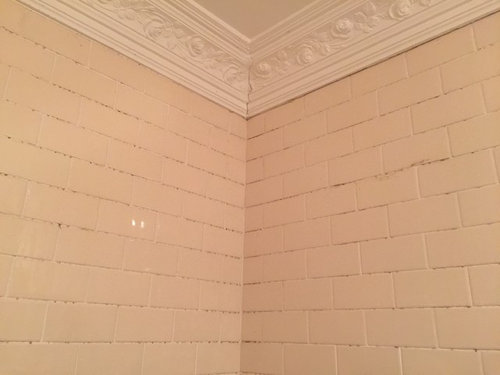Aaahhh! Mould alert! Help!
I am getting very frustrated with all this mould in our bathroom. I don't like chemicals but i have used them and it just keeps coming back!
This is above our shower. There is a fan but maybe it's not working well enough. Or is this inevitable? Should I get the grout redone? Please help!

Comments (14)
Amber Jeavons Ltd
8 years agoHello Sharon,
It sounds like a ventilation problem.. Have a look at that first and replace the fan. It may be a good idea to leave the bathroom door open a while to allow airflow too. Use a toothbrush and a good cleaner or make a bleach and water solution (a small capful of bleach will be enough in hot water.. to brush between the grout with a strong bristle toothbrush.... If it doesn't clean off then consider re-grouting.. The other thing is buy a squeegee... to wipe off excess water.. These ideas might help but do look at the extraction! : ))
karenleonn
8 years agoQuestion- does your exhaust actually go to the outside? I know it seems obvious but you would be surprised how many just vent into the roof cavity.georgi02
8 years agoYou need to do as Wuff advises - also check that there's no water coming in from above (if it's failed, it's time to think about a bathroom reno or partial reno) - if this is Ok then definately get your exhaust fan serviced or replaced (get the most efficient you can and one that can be programmed for a delayed turn-off) and then hit the entire bathroom in a bit of a cleaning frenzy. I can see that you've got sections of grout coming out - it's also worth re-grouting (horrible job) - just make sure that you remove all the grout before applying fresh grout.
I find that hot water, white vinegar (equal parts) and a half a cup of rubbing alcohol with a few drops of dishwashing detergent work a treat in any space but particularly where there's any porous surfaces (make sure you use rubber gloves - it's pretty harsh on your hands) - just replenish your solution when it starts getting grubby and cold - the alcohol and vinegar kill the mould spores, and the water and dishwashing provides general washing assistance. (Bleach will take the black colouring from mould but wont kill it completely in porous surfaces such as grout so use bleach afterward if the vinegar and alcohol don't work). Make sure that you dry out the area fully - if you've got a dehumidifier now's the time to use it.
Going forward, get a glass squeegee and use it to get rid of excess water after you've used your shower - also cut down on the amount of steam generated if you can.
You can also make a homemade bathroom cleaner (3 parts water, 1 part rubbing alcohol, 1 part vinegar a small dash of dishwashing detergent and 15-20 drops of teatree oil) spray it down and use bicarb of soda sprinkled on a cloth to clean down your tiles, tub and grout.
KK1000
8 years agoIf you have a window keep it open at all times. Invest in good security screen that will let you keep window open 24/7 and a good fan . You can never get rid of mould 100% unless you regrout because you can't kill all the spores. Make sure you clean bathroom weekly, there is no easy fix I have tried everything but this works.
Kerrie Langloy7
8 years agoFrom what i can see of your photo it isn't tiled. Bathrooms have to be properly waterproofed, sealed & tiled otherwise the surface just soaks up the moisture & mold grows. I think you need to renovate & properly waterproof the bathroom to get rid of this problem.
denise595
8 years agoOnce you clean and regrout you can also buy a sealing product (there's one which goes over the only the grout or one that goes over the whole tiles+grout- the latter would be easier). This might help stop it coming back and be easier to clean.
Also if your fan is only vented into the roof - make sure the vent is pointing up (I've tied mine off with string hanging from a rafter so its well above insulation) and if its too big a job to put in an external flue, a whirly bird in the roof is generally an easy solution.
Cloudyhaze
5 years agoGrr I wrote a huge response and the app blanked and deleted it just as I pushed send.. sigh.. here goes again...
We have (& are) going Thru a huge 2+ year Mould issue. My wife is American & I had debated black and blue with her about her “paranoia” around this supposed Mould. WELL 2yrs later I have researched high & low & learnt that Aus is decades behind the U.S in knowledge, understanding, & building codes in relation to Mould!
We learnt that, YES airflow is needed, BUT biggest requirement is calculating your room size (search for the formula but I think it’s width x height x length / 15 (15 fresh air room replacement cycles p/hr) gets the m2/hr airflow requirement fan for your bathroom size, and purchase a DUCTABLE exhaust that is slightly above the room requirement to account for loss of ducting distance air pressure. As mentioned get a timer controlled as fans should run minimum 30mins after a shower to extract moisture.
Contrary to what was mentioned earlier, a misconception in colder climates like here in melb is to NOT leave windows permanently open. This is a huge issue as it is simply letting damp humid air INTO the room. Instead windows should ONLY be opened on warm days, northerly breeze etc.
Clean as per previous comments. We learnt a great home made natural cleaning solution off Baz from “The Living Room” show on ch9. It can also be sourced online. Clean area so long as Mould hasn’t grown and contaminated right thru wall.
By a little $3 digital temperature humidity gauge off eBay and place in bathroom to show humidity year round. Get a portable dehumidifier and run regularly if humidity shows regularly to high due to poor heat in room... hope that helps...Nelson Interior Stylists
5 years agoHi there.
Like you i have had this issues with a 1947 home we purchased this year.
With mould i have been pulling my hair out as the last owners so kindly painted over the mould so it was not showing and now we have the issue.
After having experts in the field come out and inspect our home - we have one real issue and that is that we have what is called rising damp.
Basically the fan was not big enough and most man made solutions will only put the mould at bay for a small amount of time (not actually killing it)
You need to get a company in that will actually kill the issue.
For us, our home is solid brick at the back of the home (the only part that has mould) so the only solution is to demolish th back of the home and restart.
If we did not have double brick we could have simply removed tiles, water proffed and started again.
Good luck but old homes need lots of TLCOnlineWaterproofingShop
5 years agoMould on mortar lines is not unusual and is due to the mortars ability to stay wet longer
spmm
5 years agoAmericans have very poor building regulations which are different in every location, inspections are often negligible. —- One reason their house are so cheap! — I have heard some true first hand horror stories about mould in the US growing invisibly in wall cavities and making people very ill. —— steam from a shower will be hotter than outside so let it out via a window and or a properly rated exhaust fan—- have shorter showers - 4mins —- open the bathroom door a crack to provide ventilation. —- etc :)juliamac19
5 years agoShannon Lush - the cleaning guru! recommends using Oil of Cloves as this actually kills the mould spores. Other products like exit mould vinegar or bleach simply bleach the stuff without killing the actual mould. Exit Mould has the added advantage of eating your grout without resolving the problem! . Try Googling Shannon's book, as I am not sure what the proportions of clove oil
OnlineWaterproofingShop
5 years agoAccording to Moldpedia - Like bleach, ammonia will kill mold on hard non-porous surfaces such as countertops, glass or tiles but it is ineffective at killing mold growing in porous material such as wood or drywall. Another disadvantage of using ammonia is that it is a harsh, toxic chemical.
Killing mould is difficult in bakeries bread is baked at up to 300 degrees C and still grow mold 3-5 days later
Usually all your doing is removing active mould growth and deactivating the mould spores





wuff